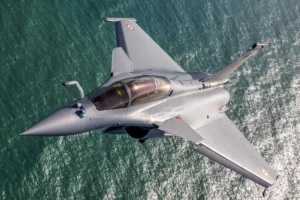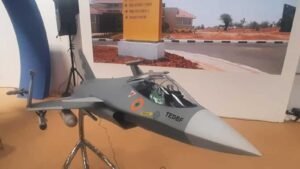https://www.defencenews.in/2023/10/indian-su-30mki-set-for-massive-%E2%82%B960000-crore-upgrade-international-media/https%3A%2F%2Fwww.defencenews.in%2F2023%2F10%2Findian-su-30mki-set-for-massive-%25E2%2582%25B960000-crore-upgrade-international-media%2F
India unveils massive upgrade plans for its fighter jet fleet to bolster its air defence capabilities
Last week, the Indian Air Force (IAF) announced a comprehensive upgrade plan for its Su-30MKI fleet.
Valued at over ₹60,000 crore ($7.5 billion), this ambitious initiative will encompass a wide range of enhancements for the fighter jets, with the exception of their airframes and engines.
Hindustan Aeronautics Limited (HAL) leads this transformation in collaboration with the Indian Air Force and other strategic partners, marking a significant step towards indigenous defence capabilities.
The upgrade program, scheduled to take four to five years for design and development, will ultimately modernize a hundred Su-30MKI aircraft in its initial phase.
Revamping Combat Capabilities

According to a report, the modernization efforts will primarily focus on upgrading avionics, radars, and electronic warfare systems, delivering a substantial boost to the fighter’s combat capabilities.
Among the reported upgrades are enhancements to the beyond visual range (BVR) capability, electronic warfare suites, and the introduction of a new radar system.
Air Chief Marshal V R Chaudhary, Chief of Air Staff, emphasized the importance of homegrown development, stating:
“We have decided this upgrade will be done indigenously with a plethora of indigenously-designed weapons, electronic warfare systems, and the like. We are looking at upgrading 84 Sukhois in the first tranche.”
Notably, the Su-30MKI fleet has been undergoing incremental upgrades for over a decade, integrating indigenous weapons such as BrahMos and Astra air-to-air missiles.
The forthcoming enhancements include Rudram-1 new generation anti-radiation missiles (NGARMs), Rudram-2, Rudram-3, and Astra-2, which promise to augment its ground-target destruction capabilities.
Focus On Electronic Warfare
One key focus of the upgrade is electronic warfare, with HAL showcasing a schematic for an electronic warfare suite during Aero India 2023. This suite aims to replace the current Russian SAP-51 pods, illustrating India’s commitment to indigenous technological advancements.
Talks on this significant upgrade have been ongoing with Russia since 2017, emphasizing the desire to maximize indigenous systems in the aircraft.
In November 2019, reports indicated that Russia would support the development of a prototype for the upgraded Su-30MKI at HAL.
However, the decision not to upgrade the Su-30MKI’s engines has raised eyebrows. Despite Russia’s development of a variant of the Su-35 fighter’s AL-41F-1S engine suitable for the Su-30MKI, the IAF seems committed to maintaining the existing powerplant.
This decision, ostensibly driven by cost considerations and a preference for beyond-visual-range combat, could impact the fighter’s overall performance.
Enhancing Combat Prowess: Su-30SM2 And Radar Speculations
The Su-30SM2, which is analogous to the Su-30MKI and features the AL-41F-1S engine, offers a 16 percent increase in maximum thrust, twice the service life, and greater electrical power generation capabilities for advanced radar and EW systems.
These upgrades translate into improved combat capabilities, as demonstrated by the higher-powered Irbis radar on the Su-30SM2, which enhances target detection ranges.
Notably, adding weight to fighter aircraft during upgrades can adversely affect thrust-to-weight ratios and overall combat performance, a lesson learned from the Jaguar upgrade program.
The Su-30MKI upgrade plan also includes a new radar system, with speculations suggesting a radar comparable to an active electronically scanned array (AESA) unit.
The Tikhomirov NIIP N035 Irbis E radar, currently fitted on the Su-35S, is considered a likely candidate. However, without an engine upgrade, the Su-30MKI may face challenges providing sufficient electrical power for such a radar, potentially necessitating using the indigenously developed Uttam AESA radar in the second tranche of upgrades.
The Uttam radar, which is set to be integrated with TEJAS MK-1, presents a promising avenue for future upgrades but may require time for further development and deployment.
IAF’s Other Ambitious Procurement Plans
In addition to the extensive upgrades planned for its Su-30MKI fleet, the IAF is making significant strides in bolstering its entire defence capabilities through a series of strategic procurements valued at approximately ₹1.7 trillion ($21 billion).
These investments, totalling ₹41 billion ($493 million) for the 2024 financial year, demonstrate the IAF’s steadfast commitment to bolstering its arsenal with indigenous platforms, including:
TEJAS Fleet Expansion
The IAF is set to procure 97 additional Hindustan Aeronautics TEJAS MK-1A fighters, addressing the retirement of the aging MiG-21 fleet. With an estimated ₹1.15 trillion ($13.8 billion), this acquisition complements a previous contract for 83 Tejas Mk-1As, with deliveries commencing in February 2024.
Light Combat Helicopter Procurement
Leading the procurement of 156 additional Light Combat Helicopters (LCHs), the IAF will receive 66, with the army acquiring the remaining 90.
AEW&C Platforms Expansion
The IAF is pursuing six more Embraer ERJ-145-based airborne early warning and control (AEW&C) platforms (‘Netra’) and converting ex-Air India A321s into AEW&C platforms under the ₹110 billion AEW&C Mk II program.
ISR Capability Enhancement
To augment intelligence, surveillance, target acquisition, and reconnaissance capabilities, the IAF is seeking three aircraft at an estimated cost of ₹60 billion. India’s Su-30MKI upgrade plan represents a monumental leap toward bolstering the country’s air defence capabilities.
While the decision to retain the existing engine and the choice of radar technology remain subject to scrutiny, the commitment to indigenous development and technological advancement is evident. The success of this upgrade program will undoubtedly significantly impact India’s strategic air power in the years to come.
Related







